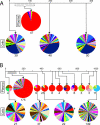Limits on replenishment of the resting CD4+ T cell reservoir for HIV in patients on HAART
- PMID: 17784786
- PMCID: PMC1959378
- DOI: 10.1371/journal.ppat.0030122
Limits on replenishment of the resting CD4+ T cell reservoir for HIV in patients on HAART
Abstract
Whereas cells productively infected with human immunodeficiency virus type 1 (HIV-1) decay rapidly in the setting of highly active antiretroviral therapy (HAART), latently infected resting CD4(+) T cells decay very slowly, persisting for the lifetime of the patient and thus forming a stable reservoir for HIV-1. It has been suggested that the stability of the latent reservoir is due to low-level viral replication that continuously replenishes the reservoir despite HAART. Here, we offer the first quantitative study to our knowledge of inflow of newly infected cells into the latent reservoir due to viral replication in the setting of HAART. We make use of a previous observation that in some patients on HAART, the residual viremia is dominated by a predominant plasma clone (PPC) of HIV-1 not found in the latent reservoir. The unique sequence of the PPC serves as a functional label for new entries into the reservoir. We employ a simple mathematical model for the dynamics of the latent reservoir to constrain the inflow rate to between 0 and as few as 70 cells per day. The magnitude of the maximum daily inflow rate is small compared to the size of the latent reservoir, and therefore any inflow that occurs in patients on HAART is unlikely to significantly influence the decay rate of the reservoir. These results suggest that the stability of the latent reservoir is unlikely to arise from ongoing replication during HAART. Thus, intensification of standard HAART regimens should have minimal effects on the decay of the latent reservoir.
Conflict of interest statement
Figures


References
-
- Chun TW, Carruth L, Finzi D, Shen X, DiGiuseppe JA, et al. Quantification of latent tissue reservoirs and total body viral load in HIV-1 infection. Nature. 1997;387:183–188. - PubMed
-
- Finzi D, Hermankova M, Pierson T, Carruth LM, Buck C, et al. Identification of a reservoir for HIV-1 in patients on highly active antiretroviral therapy. Science. 1997;278:1295–1300. - PubMed
-
- Chun TW, Finzi D, Margolick J, Chadwick K, Schwartz D, et al. In vivo fate of HIV-1-infected T cells: Quantitative analysis of the transition to stable latency. Nat Med. 1995;1:1284–1290. - PubMed
-
- Wong JK, Hezareh M, Gunthard HF, Havlir DV, Ignacio CC, et al. Recovery of replication-competent HIV despite prolonged suppression of plasma viremia. Science. 1997;278:1291–1295. - PubMed
Publication types
MeSH terms
Substances
Grants and funding
LinkOut - more resources
Full Text Sources
Other Literature Sources
Medical
Research Materials

